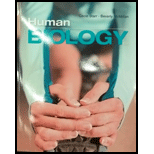
Human Biology (MindTap Course List)
11th Edition
ISBN: 9781305112100
Author: Cecie Starr, Beverly McMillan
Publisher: Cengage Learning
expand_more
expand_more
format_list_bulleted
Concept explainers
Textbook Question
Chapter 20, Problem 6CT
About 4 percent of people of Northern European descent have a cystic fibrosis allele, but only about 1 in 2,500 of these people actually has the disorder. What is the most likely reason for this finding?
Expert Solution & Answer
Want to see the full answer?
Check out a sample textbook solution
Students have asked these similar questions
↑
LED
Tt O
Tt e 0 ✓
B
>
FLORES DIology Second Semester Review
7. Chi Square Analysis: wild dumpy male x ebony wild female
F1:
All wild wild
F2:
142 wild wild males
52 wild ebony males
46 dumpy wild males
17 dumpy ebony males
151 wild wild females
47 wild ebony females
51 dumpy wild females
8 dumpy ebony females
What pattern of inheritance is observed for body color?
Autosomal recessive
Autosomal dominant
Sex-linked recessive
Sex-linked dominant
What are the genotypes of the parents in the P generation?
a.
XBYdd x XbXbDD
b. Bbdd x bbDd
c. BBdd x bbDD
d. BBX Y x bbXDY
How many flies in the F2 generation would you expect to express the dumpy wild phenotype?
a.
289.125
b. 97
c. 96.375
d. 293
4. This question focuses on entrainment.
a. What is entrainment?
b. What environmental cues are involved in entrainment, and which one is most influential?
c. Why is entrainment necessary?
d. Assuming that a flash of darkness is an effective zeitgeber, what impact on circadian
rhythms would you expect to result from an event such as the 2024 solar eclipse (assume
it was viewed from Carbondale IL, where totality occurred at about 2 pm)? Explain your
reasoning. You may wish to consult this phase response diagram.
Phase Shift (Hours)
Delay Zone
Advance Zone
Dawn
Mid-day
Dusk
Night
Dawn
Time of Light Stimulus
e. Finally, give a real-world example of how knowledge of circadian rhythms and
entrainment has implications for human health and wellbeing or conservation biology.
This example could be from your reading or from things discussed in class.
Generate one question that requires a Punnet Squre to solve the question. Then show how you calculate the possibilities of genotype and phenotype
Chapter 20 Solutions
Human Biology (MindTap Course List)
Ch. 20 - Prob. 1RQCh. 20 - What is a carrier of a genetic trait?Ch. 20 - What evidence indicates that a trait is coded by a...Ch. 20 - Prob. 4RQCh. 20 - Explain what nondisjunction is, and give two...Ch. 20 - _______ segregate during ______. a. Homologues;...Ch. 20 - Prob. 2SQCh. 20 - Genes on the same chromosome tend to stay together...Ch. 20 - Prob. 4SQCh. 20 - A chromosomes structure can be altered by _______....
Ch. 20 - Nondisjunction can be caused by ________. a....Ch. 20 - A gamete affected by nondisjunction could have...Ch. 20 - Genetic disorders can be caused by __________. a....Ch. 20 - A person who is a carrier for a genetic trait...Ch. 20 - Prob. 10SQCh. 20 - If a couple has six boys, what is the probability...Ch. 20 - Human sex chromosomes are XX for females and XY...Ch. 20 - People with Down syndrome have an extra copy of...Ch. 20 - Prob. 4CTCh. 20 - Prob. 5CTCh. 20 - About 4 percent of people of Northern European...Ch. 20 - The following pedigree shows the pattern of...
Knowledge Booster
Learn more about
Need a deep-dive on the concept behind this application? Look no further. Learn more about this topic, biology and related others by exploring similar questions and additional content below.Similar questions
- Briefly state the physical meaning of the electrocapillary equation (Lippman equation).arrow_forwardExplain in a small summary how: What genetic information can be obtained from a Punnet square? What genetic information cannot be determined from a Punnet square? Why might a Punnet Square be beneficial to understanding genetics/inheritance?arrow_forwardIn a small summary write down:arrow_forward
- Not part of a graded assignment, from a past midtermarrow_forwardNoggin mutation: The mouse, one of the phenotypic consequences of Noggin mutationis mispatterning of the spinal cord, in the posterior region of the mouse embryo, suchthat in the hindlimb region the more ventral fates are lost, and the dorsal Pax3 domain isexpanded. (this experiment is not in the lectures).a. Hypothesis for why: What would be your hypothesis for why the ventral fatesare lost and dorsal fates expanded? Include in your answer the words notochord,BMP, SHH and either (or both of) surface ectoderm or lateral plate mesodermarrow_forwardNot part of a graded assignment, from a past midtermarrow_forward
arrow_back_ios
SEE MORE QUESTIONS
arrow_forward_ios
Recommended textbooks for you
 Human Biology (MindTap Course List)BiologyISBN:9781305112100Author:Cecie Starr, Beverly McMillanPublisher:Cengage Learning
Human Biology (MindTap Course List)BiologyISBN:9781305112100Author:Cecie Starr, Beverly McMillanPublisher:Cengage Learning Human Heredity: Principles and Issues (MindTap Co...BiologyISBN:9781305251052Author:Michael CummingsPublisher:Cengage Learning
Human Heredity: Principles and Issues (MindTap Co...BiologyISBN:9781305251052Author:Michael CummingsPublisher:Cengage Learning- Case Studies In Health Information ManagementBiologyISBN:9781337676908Author:SCHNERINGPublisher:Cengage
 Biology (MindTap Course List)BiologyISBN:9781337392938Author:Eldra Solomon, Charles Martin, Diana W. Martin, Linda R. BergPublisher:Cengage Learning
Biology (MindTap Course List)BiologyISBN:9781337392938Author:Eldra Solomon, Charles Martin, Diana W. Martin, Linda R. BergPublisher:Cengage Learning Concepts of BiologyBiologyISBN:9781938168116Author:Samantha Fowler, Rebecca Roush, James WisePublisher:OpenStax College
Concepts of BiologyBiologyISBN:9781938168116Author:Samantha Fowler, Rebecca Roush, James WisePublisher:OpenStax College

Human Biology (MindTap Course List)
Biology
ISBN:9781305112100
Author:Cecie Starr, Beverly McMillan
Publisher:Cengage Learning

Human Heredity: Principles and Issues (MindTap Co...
Biology
ISBN:9781305251052
Author:Michael Cummings
Publisher:Cengage Learning


Case Studies In Health Information Management
Biology
ISBN:9781337676908
Author:SCHNERING
Publisher:Cengage

Biology (MindTap Course List)
Biology
ISBN:9781337392938
Author:Eldra Solomon, Charles Martin, Diana W. Martin, Linda R. Berg
Publisher:Cengage Learning

Concepts of Biology
Biology
ISBN:9781938168116
Author:Samantha Fowler, Rebecca Roush, James Wise
Publisher:OpenStax College
TISSUE REPAIR Part 1: Repair - Regeneration; Author: ilovepathology;https://www.youtube.com/watch?v=t-5EjlS6qjk;License: Standard YouTube License, CC-BY